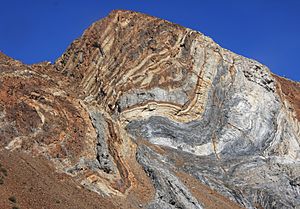Convict Lake facts for kids
Quick facts for kids Convict Lake |
|
|---|---|

Convict Lake, with Laurel Mountain in the background
|
|
| Location | Mono County, California |
| Coordinates | 37°35′20″N 118°51′29″W / 37.589°N 118.858°W |
| Basin countries | United States |
| Max. length | 0.9 mi (1.4 km) |
| Max. width | 0.4 mi (0.6 km) |
| Surface area | 170 acres (69 ha) |
| Max. depth | 140 feet (43 m) |
| Surface elevation | 7,850 ft (2,393 m) |
Convict Lake is a beautiful lake found in Mono County, California, in the Sierra Nevada mountains. It is famous for its bright turquoise-blue water and the tall, dramatic mountains around it. People also love to go trout fishing here.
The lake has an interesting history. The Paiute people, who lived in the area, called it Wit-sa-nap. Later, settlers renamed it Convict Lake after an event in 1871. In this event, a group of people who had escaped from a prison in Carson City, Nevada, were found near the lake. A group of local citizens followed them, and a conflict happened. The lake was then named to remember this event.
Contents
Exploring Convict Lake: Geography

Convict Lake was formed a very long time ago by huge sheets of ice called glaciers. The surface of the lake is about 7,850 feet (2,390 m) above sea level. In some spots, the lake is about 140 feet (43 m) deep, making it one of the deepest lakes in the Sierra Nevada mountains.
The lake has an oval shape and sits in a deep valley surrounded by mountains. Mount Morrison is the tallest mountain nearby, standing at 12,241 feet (3,731 m). It is located to the southeast of the lake.
The rocks around the lake are mostly light-colored granite. This granite formed when hot, melted rock called magma pushed up from deep inside the Earth. As the magma cooled, it became the granite we see today. The extreme heat and pressure also changed other rocks nearby into interesting shapes.
The Story Behind the Name: History
The Paiute Indians of this area had their own name for Convict Lake: Wit-sa-nap. They believed that the streams flowing from the mountains were home to "water babies." These were spirits that looked like Indian children with fish bodies.
The lake was once known to European settlers as Monte Diablo. It got its current name, Convict Lake, after a dramatic event. In September 1871, a group of people escaped from the Nevada State Prison in Carson City. One group was led by a man named Charlie Jones. He knew the area well and led his group south towards the Mammoth Lakes region.
The escaped group needed food and supplies. A young mail rider named Billy Poor accidentally met the group near Convict Creek. The group worried he would tell others where they were. Sadly, Billy Poor was harmed, and his horse and clothes were taken.

The local community was very upset about what happened to Billy Poor. A new group of citizens, led by Deputy Sheriff George Hightower and Indian deputy Mono Jim, went after the escaped group. On September 23, 1871, they caught up to some of the escaped people near Monte Diablo Creek. A conflict took place, and two members of the local group, Robert Morrison and Mono Jim, were killed.
The remaining escaped people were later found and captured. Mount Morrison, the highest peak in the area, was named after Robert Morrison. A smaller peak nearby was named after Mono Jim, honoring their bravery.
Fun at Convict Lake: Recreation
Convict Lake is a very popular spot for fishing. You can find different types of fish here, including rainbow trout and German brown trout. To make sure there are always enough fish for everyone, the lake is stocked with rainbow trout every week during the summer. These fish come from nearby hatcheries.
One of the biggest fish ever caught in Convict Lake was a 19+1⁄2-pound (8.8 kg) German brown trout in 1956. More recently, a 14+1⁄2-pound (6.6 kg) brown trout was caught in 1993. This was the largest trout caught in the Eastern Sierra that year!
If you enjoy hiking, there is a 3-mile (5 km) trail that goes all the way around the lake. Another trail connects the lake to the higher Sierra Crest mountains.
Images for kids
See also
 In Spanish: Lago Convict para niños
In Spanish: Lago Convict para niños




